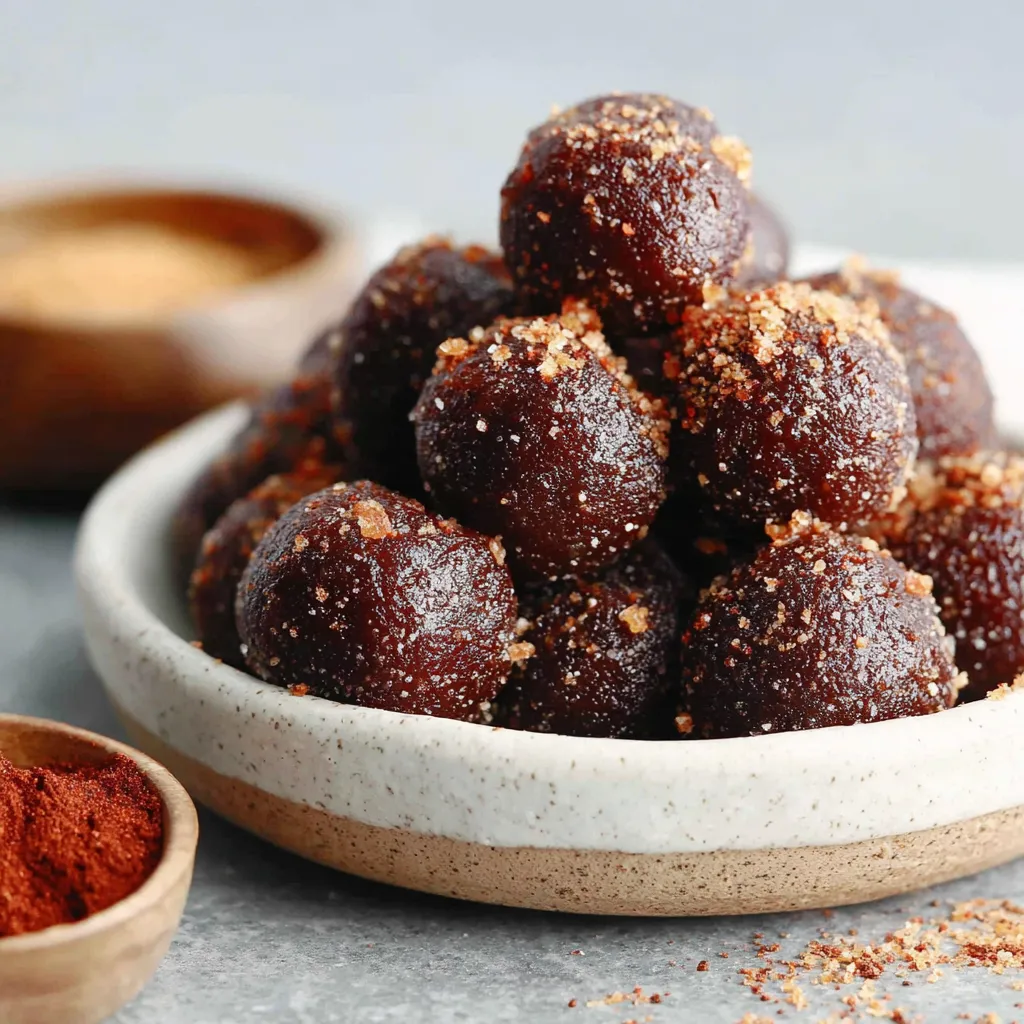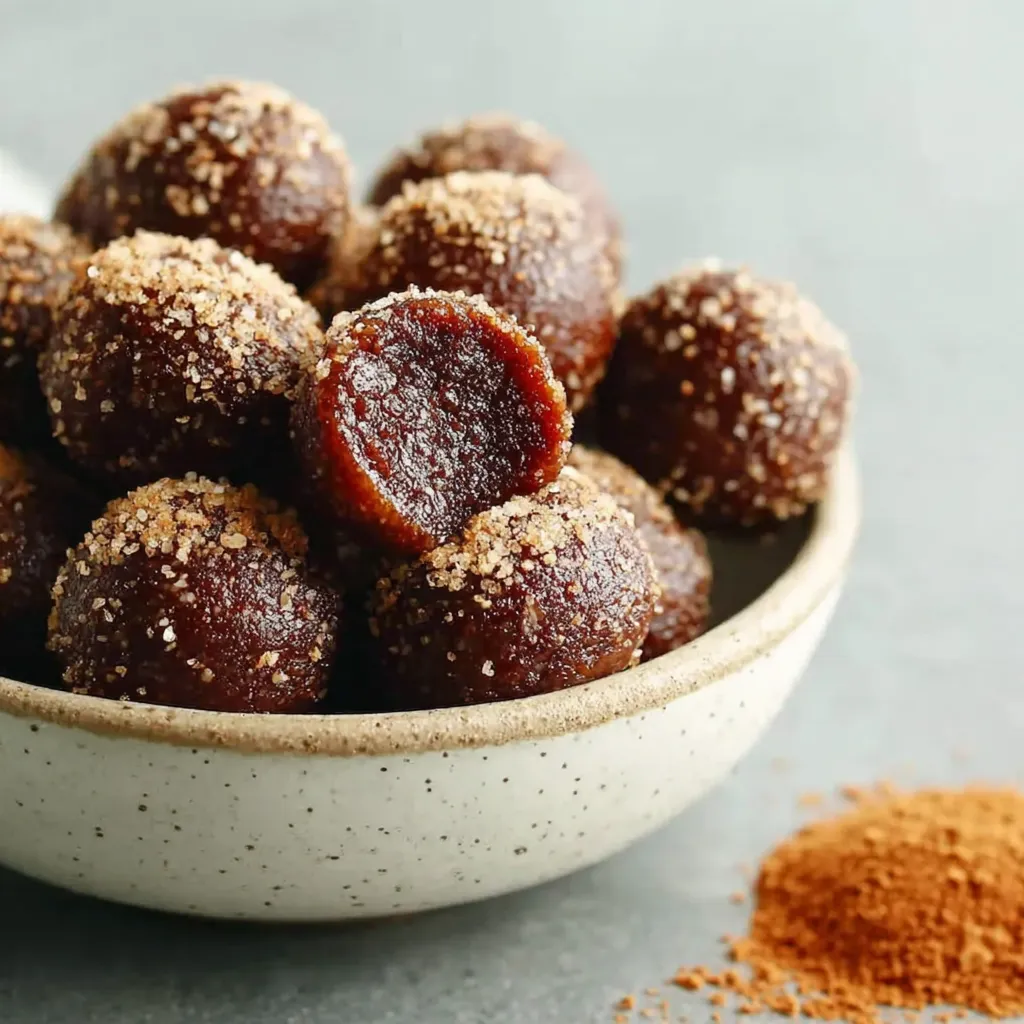 Save
Save
This tamarindo candy brings an authentic taste of Mexican street sweets right to your home kitchen. The perfect combination of sweet, tangy, and spicy flavors creates an addictive treat that showcases the versatility of the humble tamarind fruit.
I first made these candies for my daughter's cultural heritage day at school and they disappeared within minutes. Now I make a double batch whenever friends visit because everyone always asks for the recipe.
Ingredients
- 1 pound tamarind pods peeled The fresher the pods the brighter the flavor
- 1 cup hot water Helps soften the fruit for easier processing
- 16 ounces white sugar Creates the sweet counterpoint to tamarinds natural sourness
- 2 tablespoons chili lime seasoning or tajin Adds that signature Mexican heat and tang
- 4 tablespoons cornstarch Essential for binding everything together
- Extra sugar and chili powder for coating Gives the candies their finished texture
Step-by-Step Instructions
- Soak the Tamarind
- Cover your peeled tamarinds with hot water in a large bowl and let them soak for a full 20 minutes. Stir occasionally to ensure even softening. The water should turn a rich brown color as the tamarinds release their flavor.
- Prepare the Pulp
- Break the softened tamarinds into chunks with your fingers or a fork. Carefully remove the fibrous strands while keeping the seeds. The seeds provide important structure to your candy so dont discard them. The pulp should be soft and pliable at this point.
- Create the Paste
- Combine the prepared tamarind pulp with sugar chili lime seasoning and cornstarch. Mix thoroughly until everything is well incorporated into a thick sticky paste. The consistency should be similar to a very dense dough that holds its shape when molded.
- Chill the Mixture
- Refrigerate your tamarind paste for at least 20 minutes. This crucial step allows the mixture to firm up making it much easier to handle and shape into balls. A properly chilled mixture will be less sticky and hold its form better.
- Shape the Candies
- Dampen your hands slightly with water to prevent sticking and roll the chilled paste into small uniform balls about the size of a cherry. Work quickly as the mixture becomes stickier as it warms up from handling. Redampen your hands as needed throughout the process.
- Apply the Coating
- Roll each formed ball in your choice of sugar or chile powder mixture. Use spoons rather than your hands for this step to maintain a clean coating and prevent the balls from becoming too sticky or misshapen.
 Save
Save
The absolute key to perfect tamarindo candy is patience during the soaking process. My grandmother taught me that rushing this step results in a stringy texture that lacks the deep tamarind flavor that makes these candies so special.
Troubleshooting Your Tamarindo Candy
If your tamarind mixture seems too wet after combining all ingredients add a bit more cornstarch one teaspoon at a time until you reach the right consistency. Conversely if the mixture is too dry and crumbly add a few drops of warm water. The ideal texture should be pliable but firm enough to hold its shape when rolled.
Serving Suggestions
In Mexico tamarindo candies are often served alongside fresh fruit at celebrations or as an afternoon snack with agua fresca. For a special presentation arrange the candies in miniature paper cups and place them on a colorful platter garnished with lime wedges. The bright citrus complements the tangy tamarind perfectly.
Cultural Significance
Tamarind candy represents the ingenious way Mexican cuisine transforms simple ingredients into complex flavor experiences. Brought to Mexico during the Spanish colonial period tamarind became integrated into the culinary landscape much like chile peppers. These candies are a perfect example of how Mexican food artfully balances contrasting flavors sweet sour and spicy in perfect harmony.
Storage Tips
These candies will remain fresh for up to a month when stored in an airtight container at room temperature. Place parchment paper between layers to prevent sticking. In humid environments store in the refrigerator but allow them to come to room temperature before serving for the best flavor experience.
 Save
Save
Recipe FAQs
- → Why keep the tamarind seeds in the candy?
The tamarind seeds provide essential structure to the candy, helping the balls maintain their shape. Without the seeds, the paste may become too soft and difficult to form into the traditional ball shapes.
- → What is tajin and can I substitute it?
Tajin is a popular Mexican seasoning made from chile peppers, lime, and salt. If unavailable, you can substitute with a homemade mixture of chili powder, lime zest, and a pinch of salt, or use any chili-lime seasoning available at your local grocery store.
- → Why should I use spoons instead of hands when coating the candy?
Using spoons prevents the moisture and heat from your hands from dissolving the sugar coating or affecting the texture of the candy. This ensures a more even coating and prevents the candy from becoming sticky during the process.
- → How can I tell when the tamarind is properly soaked?
The tamarind is properly soaked when the pulp becomes soft and can be easily separated from the seeds and fibers. The color will deepen slightly, and the texture will be pliable enough to work with but not overly mushy.
- → Can I adjust the spiciness of the candy?
Absolutely! You can control the spiciness by adjusting the amount of chili lime seasoning or tajin in the mixture. For a milder candy, reduce the amount to 1 tablespoon, or increase it up to 3 tablespoons for a spicier kick. You can also create a variety by making some balls with just sugar coating and others with chili powder.
- → Why does the paste need to be refrigerated before rolling?
Refrigerating the paste for 20 minutes helps it firm up, making it easier to handle and roll into balls. This cooling period allows the cornstarch to fully absorb moisture and helps the sugars stabilize, resulting in candy that holds its shape better.
